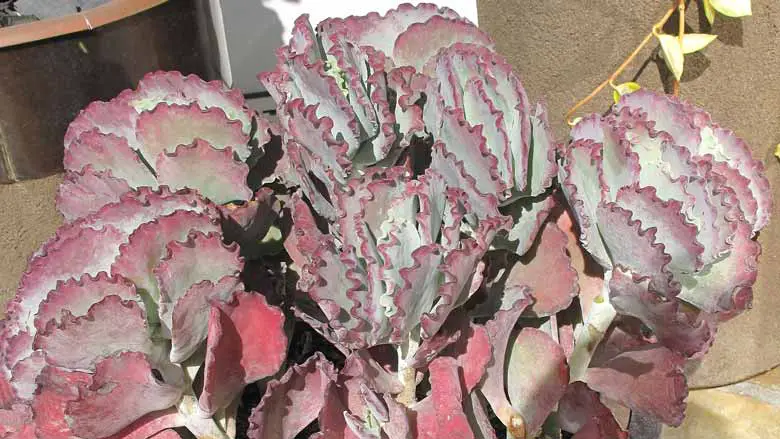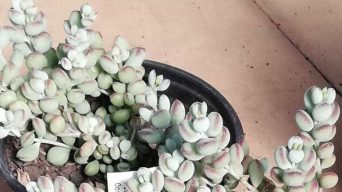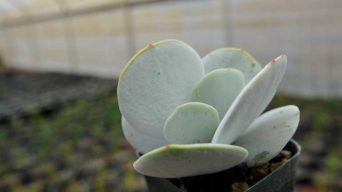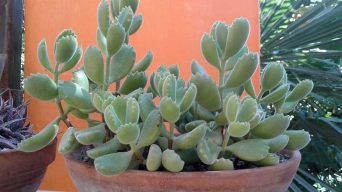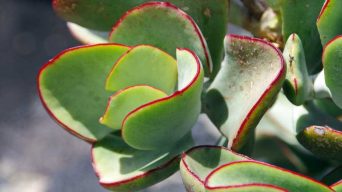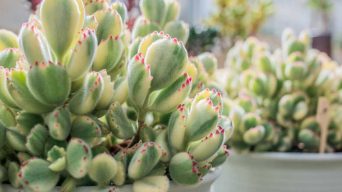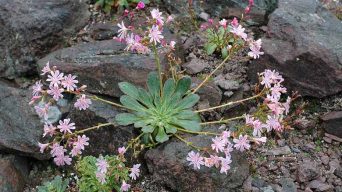Succulents are not only beautiful plants that can survive in some of the harshest environments, but they also come in a fantastic variety of colors and types.
It is no wonder that so many people are interested in keeping succulents as houseplants.
The Cotyledon undulata is incredibly easy to grow and will provide you with years of enjoyment. It makes a wonderful addition to any room in the house and is relatively low maintenance.
It also does well indoors or outdoors, so you can enjoy this plant year-round!
If you can provide it with what it needs, your plant will reward you with its beauty.
This article will cover how to take care of your Cotyledon undulata and how to propagate them for more beautiful plants just like yours!
Overview
The Cotyledon undulata is a succulent plant from the Crassulaceae family that is native to Africa.
Cotyledon undulate is a small shrub that grows up to 50 cm tall with stems coated with a thick, white layer of wax.
The leaves are scallop-shaped and grey-white to blue-grey in color, with wavy edges and a powdery waxy covering over the entire leaf.
In the summer, bright orange flowers dangle from a foot-tall inflorescence.
The Cotyledon undulate is also commonly known as Silver Crown or Silver Ruffles.
How To Care for Cotyledon Undulata
The Cotyledon undulata succulent plant is a very popular and easy to care for houseplant.
It only needs the basics to survive, which makes it an ideal candidate for newbie gardeners.
Below you’ll find the most important information you need to know about caring for Cotyledon undulata.
Sun Exposure & Light Requirements
The Cotyledon undulata succulent plant thrives in partial sun to partial shade.
Indoor plants should be placed near a west-facing or east-facing window that gets plenty of indirect, bright light year-round.
When outside, Cotyledon undulata succulents do best when they receive partial sun during the cooler months and are protected from the full midday sun.
Avoid planting these succulents in direct sunlight because the intense light may burn the leaves.
Cotyledon undulata houseplants are not picky about sun exposure but require bright light, or their colors will be less intense.
Choose a location with bright filtered light for the best color.
Watering Requirements
The Cotyledon undulata succulent is a drought-resistant plant and can survive in dry conditions for long periods.
However, they will need to be watered once a week, letting the soil dry out before watering deeply.
Be careful not to overwater them, as this can cause root rot. Water slowly and gently so that the excess moisture trickles through the soil.
Watering the plant during the day is preferable so it has time to dry off before nightfall.
If you are growing it outdoors, water early in the morning or late afternoon during hotter months.
The Cotyledon undulata should not be kept wet for long periods as this can cause root rot, which will affect its growth.
Also, ensure that water does not come into contact with the leaves, as it can cause them to rot and fall off.
Soil Requirements
The soil requirements of a cotyledon undulata succulent depend on the way it is grown.
Every cotyledon undulata needs well-draining soil, which is why cactus potting mix or succulent soil mix should be used for this plant.
Cotyledon undulata plants grown in water-retentive soil can easily develop root rot and should be placed on a cactus mix instead.
However, if you want to plant the cotyledon undulata in water-retentive soil, adding perlite or sand to it is recommended.
Temperature and Humidity
The Cotyledon undulata succulent plant needs some warmth, however not extremely high temperatures.
It might be kept at around 68° – 80° Fahrenheit (20 – 27°C) during the day and 50° – 70° Fahrenheit (10 – 21°C) on the cold nights.
To successfully grow the Cotyledon undulata, it needs times of 40 – 50% relative humidity.
Fertilizing
The Cotyledon undulata is a slow and steady plant that does not need fertilization often.
It can benefit from occasional fertilization in the growing season with a balanced liquid fertilizer diluted to half-strength.
However, this plant does not need a lot of fertilizer. It can have a severe reaction if over-fertilized. So, be sure to fertilize only when necessary for healthy growth.
Fertilizing too frequently will only promote leggy growth, and the plant won’t grow compact or solid.
Potting and Repotting
The Cotyledon undulata succulent plant is slow-growing and usually doesn’t need to be repotted, but it does need to be repotted every few years so that it isn’t rootbound.
But if you notice that it looks very rootbound, you might want to repot it. The best time for this is in spring because that’s when the plant grows new roots.
The best type of pot for this plant is a shallow pot that has good drainage.
When succulents grow in pots without drainage, they accumulate water, which leads to root rot and other problems.
But with drainage holes, the roots can dry out, thus preventing root rot.
Pruning
It is not necessary to prune the Cotyledon undulata succulent. The only time it’s recommended that you do is when removing any dead leaves or old stems.
If the plant begins to look too sparse, you can also cut back on some older branches.
But make sure to avoid pruning during the winter months, as this is when the plant is dormant and should only be done if absolutely necessary.
It’s best to prune during the spring and summer months when the plant is actively growing.
Take your time and make accurate, clean cuts with sharp trimmers to avoid tearing or splitting any branches.
Pests and Diseases
The main pests that attack the Cotyledon undulata are mealybugs and spider mites.
Because the mealybugs and spider mites are so small, it can be difficult to spot one until they have already spread to a large number of leaves.
If you catch them soon enough, though, they’re generally easy to get rid of with a few sprays from the garden hose or a cotton swab dipped in rubbing alcohol or Vodka.
If you don’t catch them soon enough, they can quickly kill an entire plant or make it look like a plant has mange.
The other main concerns besides the pests are root rot or fungal diseases. Because of the Cotyledon undulata specific soil and water need is relatively resistant to root rot and fungal diseases.
However, if they get too watered or repotted in the wrong soil at the wrong time of year, their risk of developing root rot and other fungus problems can increase.
To avoid root rot or fungal diseases, make sure your Cotyledon undulata is planted in soil that drains well and is watered sparingly. Also, only repot when needed and avoid overwatering this plant in general.
If you plant your Cotyledon undulata in well-draining soil and give it the right amount of care, then you shouldn’t need to worry about pests or fungus.
How to Care for Cotyledon Undulata in Winter
During the winter, Cotyledon undulata is a very low-maintenance plant.
However, keep in mind that these plants are not cold hardy, and you should bring them indoors before frost if your winters are cold or freeze.
The best place to overwinter this succulent is a room with bright light but no direct sunlight. Keep the soil slightly on the dry side in the winter, but do not let it completely dry out.
If you keep these plants in a cool place (50 to 55°F or 10 to 12°C), water them sparingly; once per month is enough during wintertime.
If you are growing these plants outdoors, bring them indoors before the temperature is below 40°F (5°C).
How To Propagate Cotyledon Undulata
One of the most rewarding parts about succulent plants is their ability to propagate.
You can grow an entirely new plant in no time by taking cuttings.
Cotyledon undulata is a highly easy succulent to propagate through stem cuttings, and it offers the opportunity to generate numerous cuttings to cultivate numerous new plants.
To propagate the Cotyledon undulata, follow these steps:
- Remove a cutting about 3 inches long with a clean, sharp knife or razor blade. Make sure there are at least 2 sets of leaves on your cutting.
- Allow the cutting to dry for a few days and plant it in well-draining soil. Be careful not to allow direct sunlight to fall on the cutting, as this could cause it to dehydrate.
- Keep your new Cotyledon undulata moist until you see growth starting.
- Once your new Cotyledon undulata has grown, you can transplant it into a larger pot.
The Cotyledon undulata can grow several inches tall and develop spectacularly beautiful flowers, so you will have plenty of new cuttings from which you can propagate more plants.
Growing your own Cotyledon undulata is fun, easy, and rewarding, so try it!
Is the Cotyledon Undulata Toxic?
Cotyledon succulents can be toxic if ingested. However, the Cotyledon undulata is not known to be toxic.
But it is still best to keep it out of reach of small children and pets and to avoid ingestion.
Always wash and rinse your hands after working with them and before eating or preparing food, especially if they are in contact with soil or sand.
Final Thoughts
Growing succulents is not tricky, and many different types of succulents can be grown with little effort on the gardener’s part.
Cotyledon undulata is just one of the many succulents that can be quickly grown.
Cotyledon undulata is an attractive, unique plant that can be kept as a houseplant or planted outside in the garden.
As long as the right conditions are maintained, cotyledons will thrive and can even be easily propagated!

